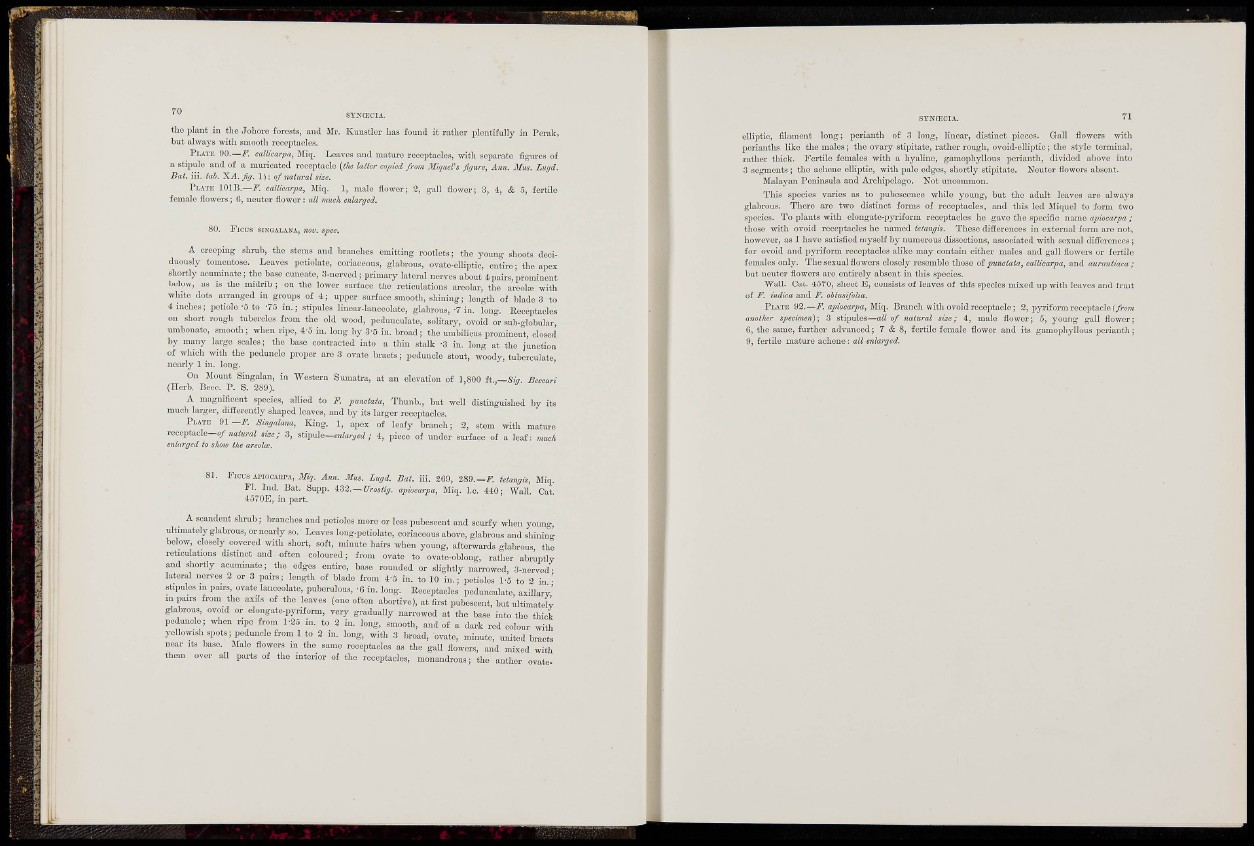
the plant ill tlic Jolioro forests, and Mr. Künstler lias found it rather plentifully in Perak,
but always with smooth reeeptaeles.
PLATE 90.—L". callicarpti^ Miq. Leaves and matui-e receptacles, with separate figures of
a stipule and of a muricated receptacle {the Mtar copied from MlqmVs fif/itrB, Ami. Mm. Luffd.
Bat. iii. tah. ^A. fig. 1); of natural size.
PUTE lOlB.—i. cdlicarpa, Miq. 1, male flower; 2, gall flower; 3, i, & 5, fertile
female flowers; 6, neuter flower: all much enlarged.
80. Ficus SINGALANA, nov. Spec.
A creeping shrab, the stems aud branches emitting rootlets; the young shoots deeiduously
tomentoso. Leaves petiolate, coriaceous, glabrous, ovate-elliptic, entire; the apex
shortly acuminate; the base cuneate, 3-nerved; primary lateral i i e ™ about 4pans,prominent
below, as is the midi-ib ; on the lower sui-face the reticulations areolar, the areolaj with
white dots ai-ranged in groups of 4; upper sm-face smooth, shining; length of blade 3 to
4 inches; petiole-o to -75 in.; stipules Knoar-lanceolate, glabrous,-7 in. long. Eeceptacles
on short rough tubercles from the old wood, peduncnlate, solitaiy, ovoid or ,sub-globular,
nmbonate, smooth; when ripe, 4-0 in. long by 3'5 in. broad; the mnbilicus prominent, closed
b y many large scales; the base contracted into a thin stalk -3 in. long at the junction
of which with the peduncle proper ai-e 3 ovate bracts; peduncle stent, woody, tubereulato
nearly 1 in. long. '
On Mount Singalan, in Western Sumatra, at an elevation of 1,800 ft.,—®», Beccari
(Herb Becc. P. S. 289).
A magnificent specie,?, alKed to F. punctata, Thnnb., but well distinguished by its
much larger, diflercntly shaped leaves, and by its larger receptacles,
PLATE 91-2?, Singalam., King, 1, apex of leafy branch; 2, stem with matme
r e c e p t a c l e - . / A c ; 3, stipule-ffli<„,ri; 4, piece of under sm-face of a leaf: much
enlarged to show the areolce.
81. FICUS APIOCARPA, L/I^. An7i. Mas. Lugd. Bat. iii. 269, 289.-?'. teiangis, Miq.
FI. Ind. Bat. Su^jp. ^Z2.— Urostif,. apiocarpa, Miq. I.e. 440; Wall. Cat.
4o70E, iu part.
A scandent shrub; branches aud petioles more or less pubescent and scurfy wlieu yoimg,
ultimately glabrous, or nearly so. Leaves long-petiolate, coriaceous above, glabrous and shining
below, closely covered ^vith short, soft, minute hairs when young, afterwards glabrous, the
reticulations distinct and often coloured; from ovate to ovate-oblong, rather abruptly
and shortly acuminatc; the edges entire, base rounded or slightly narrowed, 3-nerved •
lateral nerves 2 or 3 pairs; length of blade from 4-5 in. to 10 in.; petioles 1'5 to 8 in -
stipules in pau-s, ovate lanceolate, pubcrulous, -6 in. long. Receptacles pedunculate axillary'
inpau-s from the azils of the leaves (one often abortive), at first pubcscent, but ultimately
glabrous, ovoid or elongate-pyi-iform, very gradually narrowed at the base into the thick
peduncle; when ripe from 1-25 in. to 2 ia. long, smooth, and of a dark red colour with
yellowish spots; peduncle from 1 to 2 in. long, with 3 broad, ovate, minute, united bracts
near its base. Sfale flowers in the same receptacles as the gall flowers, and mixed with
them over all parts of the interior of the receptacles, monandi-ous; the anther ovate
elliptic, filament long; perianth of 3 long, linear, distinct pieces. Gall flowers with
periautlis like the males; the ovaiy stipitate, rather rough, ovoid-elliptic; the .stylo terminal,
rather thick. Fei-tilo females with a hyaline, gamophyllous perianth, divided above into
3 segments ; the achene elliptic, with palo edges, shortly stipitate. Neuter flowers absent.
Malayan Peniixsula and Ai-cliipolago. Not uncommon.
This species vai-ies as to pubescencc while young, but the adult leaves are always
glabrous. There ai-e two distinct forms of receptacles, and this led Miquel to form two
species. To plants with eloagate-pyi-iform receptacles he gave the specific name apiocarpa ;
those with ovoid receptacles he named tetangis. These differences in external form are not,
however, as I have satisfied ruyself by numerous dissections, associated with sexual tlifFcrcnces;
for ovoid and pyriform receptacles alike may contain either males and gall flowers or fertile
females only. The sexual flowers closely resemble those oi punctata, callicarpa, and aurantiaca ;
but neuter flowers are entirely absent in this species.
"Wall. Cat. 4570, sheet E, consists of leaves of this specics mixed up witli leaves and fruit
of F. indica and F. obtusifoUa.
PIATE 93.—i^. apiocarpa, Sliq. Branch with ovoid receptacle; 2, pyi-iform receptacle i/rom
another specimen)) 3 sti2)ules—all of natural size; 4, male flower; 5, young gall flower;
6, the same, fui'ther advanced; 7 & 8, fertile female flower and its gamopliyllous perianth;
9, fertile matm-e achcne: all enlarged.